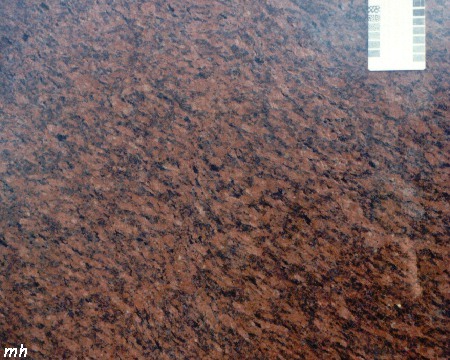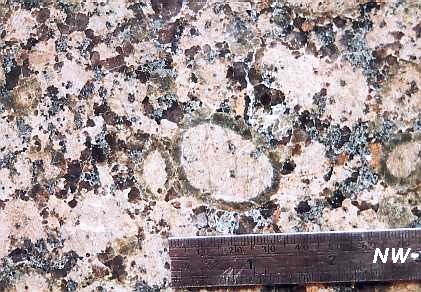Hull Geological
Society

Common urban rocks -
(a work in progress)
Granites

Granites are plutonic igneous rocks that always
contain the mineral quartz and feldspars. They have crystals that are obvious to
the naked eye because the molten magma cooled slowly allowing the crystals to
grown. They are interlocking, there is no pore space. The crystals are normally
arranged randomly without any particular orientation. The quartz is pale grey
and glassy, sometimes with a blue tinge. The feldspars are white or shades of
pink (perhaps to a dark red or sometimes yellowish). If you look carefully you
might see cleavage in the feldspar crystals (faint lines of weakness). The other
minerals in a granite are micas, hornblende and perhaps some other dark
minerals. Micas are thin platy minerals and I
would describe them as being like sequins. There are two main types of mica:
muscovite which is white and biotite which is brown. Seen end on they look like
the edge of a book; this means that water can get into them and start weathering
the rock.
Granites often have "trade names" when used as building stones or for
monuments. here are descriptions of some you might see -

"Balmoral Red" - bright red with some lineation of the crystals; it had
been squeezed and partially metamorphosed

"Baltic Brown" - distinctive rock with rapakivi structure (large balls of
crystals) and an overall brownish colour. Often seen facing Trustee Savings Bank
buildings.
Cornish and Dartmoor - pale grey overall colour with white feldspars.
"Correnni Granite" - salmon pink overall colour, small crystals, from
Aberdeen shire.
"Imperial Mahogany" - dark red granite with blue quartz, from Dakota.

Peterhead Granite - from Aberdeen shire, contains large pale pink
feldspars and may contain xenoliths
Rubislaw Granite - from Aberdeen shire, dark grey with lots of biotite
"Swedish Imperial" - pink granite with cracked feldspars
"Vergo Granite" - pink granite with cracked feldspars and blue quartz.
Copyright
- Mike Horne and Hull Geological Society 2020
Registered
Educational Charity No. 229147
Home




